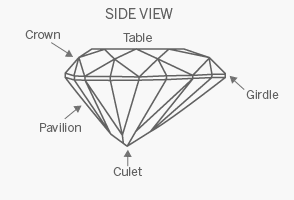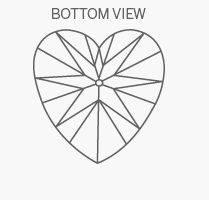Heart Cut Diamond Shape
The Essential 7C's
Every diamond has its own story, and every lady her own style.
At this point it should be noted that the shape of a diamond can also be referred to as its “cut”, like a round or princess cut. However, this should not be confused with the more commonly used term of diamond cut, which describes how well the diamond has been polished from the raw material (see section on diamond cut).
At Seventy Seven Diamonds we cater to the detailed wishes of every customer and want to ensure that they are well-informed about every diamond shape available. Our selection of beautiful shapes is accompanied by detailed information, images and recommendations on the uniqueness, the history and background, and the ideal ratio of every cut.
Heart Cut Diamonds
1. The Basics | 2. Features | 3. Expert Advice | 4. History
1. The Basics
Ever the romantic choice... This is a rare and symbolic cut.

| Unique Features |
Facets |
L/W Ratio |
Origin |
Expert Tip |
| Exclusive heart shape design. |
56 to 58 facets |
Typically 0.90 - 1.10 |
16th Century. |
Good symmetry is essential. |
2. Features



The heart shape is usually comprised of between 56 and 58 facets, although the number of main pavilion facets may vary between 6, 7 and 8. Additionally, heart shapes are sometimes cut with “French tips,” which replace the large bezel facet at the point with star and upper girdle facets. French tips are also used in the Marquise and Pear shapes. Heart shapes may differ slightly in appearance depending on their make or structure.
The traditional heart shape should have a ratio between 0.90 and 1.10 and be absolutely symmetrical with the lobes (top arches) of even height and breadth, although these specifications may be altered according to personal preferences.
In determining the length to width ratio for heart shapes, the width is measured at the widest point of the shape from the edge of one lobe to the other. In addition, the heart shape can suffer from a so-called “bow-tie effect” when light passing through the diamond casts a shadow across the central facets of the stone.
3. Expert Advice
"The most important elements to consider with the heart shape are the quality of the curved cut and finish as these determine the sparkle of the gem.
The shadow caused by the bow-tie effect can be reduced by altering the depth of the pavilion, and adjusting the angles of the table and facets to better diffuse light in the central area. This effect also occurs in the Pear, Marquise and Oval shapes."
4. History & Background
The exact origins of the heart brilliant are unknown although being a modified brilliant cut it may have appeared as early as the 16th century. However, gems which would today be classified as ‘triangular with rounded corners’ or ‘drops’ were at one time described as being heart-shaped. Indeed, this is evident from the many descriptions in French inventories dating from the middle of the seventeenth century. The first recorded heart shape diamond appears in a portrait entitled "The Gonzaga Princess,” painted circa 1605 by Frans Pourbus the younger. The large piece of jewellery on the princess’s left sleeve contains a variety of different cuts, some of which are thought to be versions of the heart-like ‘drops’ popular in France at the time. The heart shape is also mentioned in a book written in 1655 by Jean-Baptiste Tavernier, the French merchant-traveller who found his fortune in the precious stone trade and famously brought the Hope Diamond to France. In the text, he recalls seeing the “Heart Diamond,” a 36-carat heart-shaped brilliant in an ornament in the treasure of Aurangzeb, in India.

Where next?
To view heart cut diamonds offered by Seventy Seven Diamonds, please click here.
To customise your heart cut engagement ring, please click here.
If you would like to read more about diamond education, please click here.